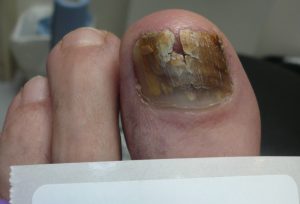Fungal Nail Infections: Understanding and Treating with Lunula Laser
Fungal nail infections are common and can make your nails look unsightly. Let’s discuss what they are, causes, and treatment options, with a spotlight on the innovative Lunula laser.
What is Onychomycosis?
- Simple Definition: Onychomycosis is the medical term for a fungal nail infection.
- Common Causes: Fungi called dermatophytes are usually responsible. This condition is more frequent as we age.
- Symptoms:
- Nails become thick, crumbly, or brittle
- Change shape or lift off the nail bed
- Lose shine and turn white, yellow, orange, or brown
- Debris build-up under the nail
- May occur alongside athlete’s foot
Treatment Options
- Talk to Your Podiatrist: They’ll assess your nails and recommend the best approach based on severity.
- Mild Cases:
- Regular trimming and thinning by a podiatrist.
- Topical antifungal medication (if no skin infection).
- Moderate to Severe Cases:
- Oral antifungal medication (tablets e.g. terbinafine).
- Surgical removal of the nail, followed by topical medication or laser.
- Lunula Laser Therapy: A cutting-edge, non-invasive treatment explained below.
Focus on Lunula Laser
- How It Works: The Lunula uses specific light wavelengths to disrupt fungal growth without harming healthy tissue.
- Benefits:
- Non-invasive and painless
- Requires no medication
- Around 60% success rate
- Our Treatment Plan:
- Consultation: We’ll discuss your case and ensure Lunula is right for you.
- Initial Phase: Typically 1-2 laser treatments per week for 3 months. Minimum of 4 treatments, ideally 8-10 depending on severity.
- Monitoring: We’ll track progress and provide follow-up care as your healthy nail grows out. An average growth of a millimetre a month so we review every 2-3 months.
Important Considerations:
- Reinfection is Possible: Good hygiene is key to prevent recurrence (treat athlete’s foot, keep shoes fungal-free).
- Results Take Time: Nails grow slowly; visible improvement may take 2-3 months.
- Not for Everyone: Lunula may not be suitable for extremely damaged nails. Your podiatrist will advise.
- Effectiveness: A recent survey of our patients (January 2024) found 64% of patients were happy with the healthy growth of the nail and would recommend the treatment to others.
Costs
- Initial Consultation: £80
- Lunula Treatment:
- One foot/hand: £270 (3-month plan)
- Both feet/hands: £540
- Both big toes: £450
- We advise attending for follow-ups every 2-3 months as the nail grows out. With this commitment from you, we will continue to provide additional lunula top ups without extra charge.
- Follow-up Appointments: £35
Is Lunula Right for You? Contact Us to Schedule a Consultation
Prices are subject to change without notice and Payment is due in full at the start of treatment.

Mr D56192 before treatment

Cosmetic Alternatives: Restore Your Nail’s Appearance
While treating a fungal infection is important, you might also want to improve the look of your nail during the process. Here’s an option:
- Pedique Nail Restoration: If your nail is damaged or disfigured from the infection, a Pedique treatment can provide a natural-looking cosmetic solution. This involves:
- Applying a specialised gel to the nail, which is moulded and bonded to create a realistic appearance.
- Covering the gel with nail polish for the desired colour and finish.
- Please note: Pedique is not suitable during active laser treatment, but it’s a great option to consider once your nail starts growing out.
Benefits of Pedique:
- Immediate Results: Enjoy a normal-looking nail right away.
- Temporary Solution: The restoration lasts 3-6 months, providing a cosmetic fix while your healthy nail grows.
- Versatile: Pedique is an option even if the infection is gone but the nail remains damaged.
Interested in Pedique? Click here for more information.
.

